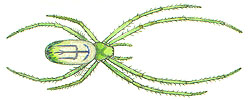 |
|
| You Are Here: Burke Museum : Spider Myths : General : Sucking Juices |
General Fallacies
Myth: Spiders do not literally eat the insects they kill; they only suck the "juices" or blood.
Fact: You can find this myth in many books; even
some scientists, who have never bothered to look for themselves, believe it.
There is not a particle of truth in this idea! Spiders are not miniature vampires;
all species, as far as we know, digest some solid parts of their prey. What
makes it especially interesting is that the digestion process begins outside
the spider, where anyone who wants to look can see how it works.
Put a medium-sized insect in the web of a large orbweaving
spider in the garden. You will see the spider bite the prey, wrap it in silk,
wait for it to die, then begin to eat. As a first step in eating, the spider
will literally vomit digestive fluid over the prey. Then the prey is chewed
with the "jaws" (chelicerae), and the fluid is sucked back into the
mouth together with some liquefied "meat" from the prey. The spider
repeats this process as often as necessary to digest, and ingest, all but the
inedible hard parts. What is discarded afterwards is a small ball of residue.
Spiders other than orbweavers may eat the prey's body but discard some of the
wings, legs, etc. Spiders with very small (if strong) jaws (such as crab spiders and cobweb
weavers) make small holes in the prey and vomit their digestive fluid into
the prey's body, the end result being a hollow shell with some or most of the muscles and
internal organs digested and sucked out.
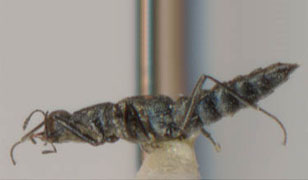 |
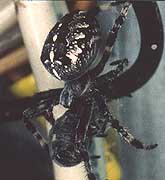 |
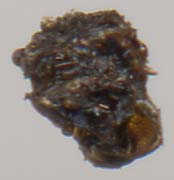 |
| A common rove beetle,
Stenus comma, 5 mm long, as it appears when uneaten by spider. Scanned from specimen |
Cross spider, Araneus
diadematus, with (different) beetle prey Bob Thomson photo |
Remains (1.5 mm) of rove beetle with cross spider
nearly done feeding. Scanned from specimen |
|
Before. . . . . . . . . . . . . . . . . . . . . . . . . . . . . . . . . . . . .
. . . . . and after. Small rove beetles like Stenus comma (left) fly well and are sometimes caught by orbweavers like Araneus diadematus (center, preparing to eat a different beetle); the much smaller remains (right, enlarged) of a rove beetle of the same size and shape show the results of external digestion! |
||
| Previous Myth | Myths Home | Web Resources | Next Myth |
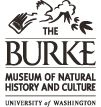 |
Text ©
2003-2010, Burke Museum of Natural History & Culture, University of Washington, Box 353010, Seattle, WA 98195, USA Phone: 206-543-5590 Photos © as credited |
Queries
to Spider Myths author, Rod Crawford This page last updated 2 September, 2010 This site best viewed at 800 x 600 using IE 5.0 or above. |